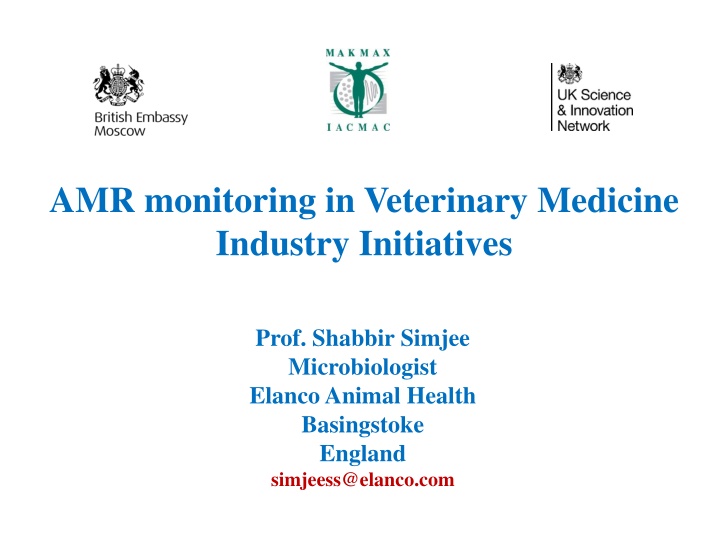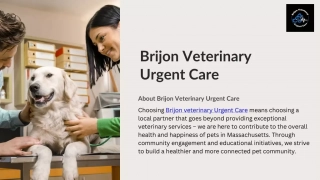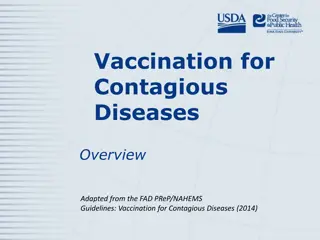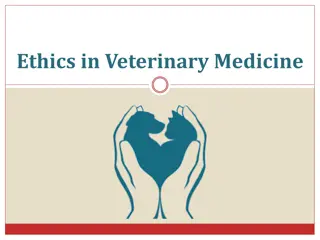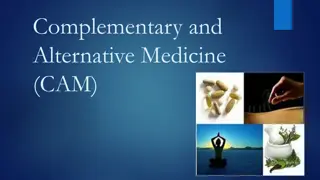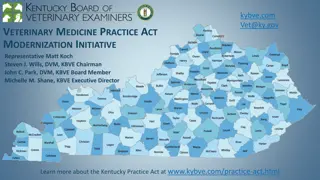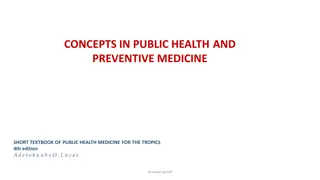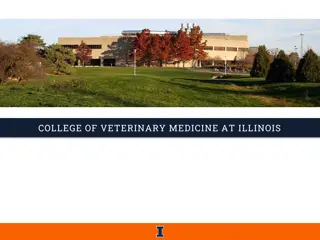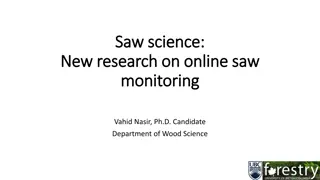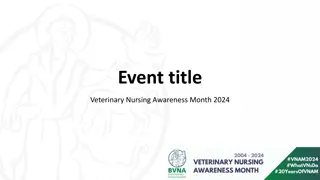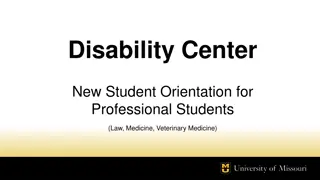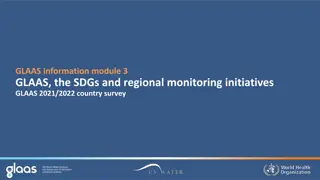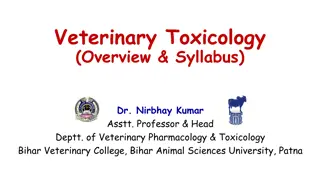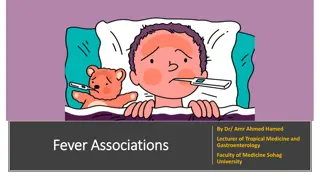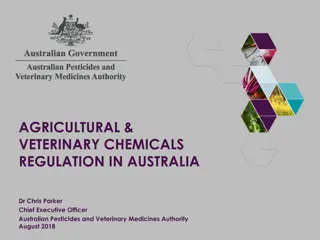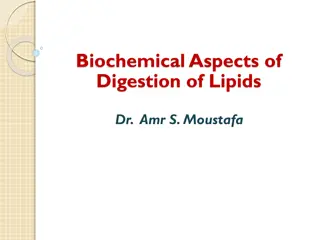AMR monitoring in Veterinary Medicine Industry Initiatives
In the veterinary medicine industry, initiatives for monitoring antimicrobial resistance (AMR) are crucial. Prof. Shabbir Simjee, a renowned microbiologist at Elanco Animal Health, has been actively involved in various global surveillance programs and initiatives to combat AMR. His expertise and contributions have significantly impacted the field of veterinary medicine. The importance of harmonization in surveillance programs, as outlined by Franklin et al. in 2001, underscores the need for unified data interpretation and quality control to effectively address the emergence of AMR.
Download Presentation

Please find below an Image/Link to download the presentation.
The content on the website is provided AS IS for your information and personal use only. It may not be sold, licensed, or shared on other websites without obtaining consent from the author.If you encounter any issues during the download, it is possible that the publisher has removed the file from their server.
You are allowed to download the files provided on this website for personal or commercial use, subject to the condition that they are used lawfully. All files are the property of their respective owners.
The content on the website is provided AS IS for your information and personal use only. It may not be sold, licensed, or shared on other websites without obtaining consent from the author.
E N D
Presentation Transcript
AMR monitoring in Veterinary Medicine Industry Initiatives Prof. Shabbir Simjee Microbiologist Elanco Animal Health Basingstoke England simjeess@elanco.com
Background 2000 - 2003 US FDA, Antibiotic resistance monitoring, risk assessment and scientific support for veterinary antibiotic registration 2004 Elanco Animal Health global microbiologist/antibiotics technical consultant 2008 2014 Chair of the CEESA VetPath, Pan-Eu antimicrobial resistance monitoring program 2012 Co-Chair of CLSI VAST sub-committee (Chair 2016 - 2020) Editor for JAC (9 years), AAC (10 years) and IJAA (9 years +) Over 80 peer reviewed papers and conference presentations, 2 books and 9 book chapters
Global Surveillance Programs Veterinary examples FARM VAV MARAN NVAL CIPARS Mexican DANMAP SVARM GermVet NARMS JVARM Brazil
Global Surveillance Programs All the national programs focus predominantly on foodborne and commensal bacteria The data generated from these surveillance programs are used for registration purposes, as an indicator for the emergence of resistance and for National Risk Assessment and subsequent Risk Management guidelines It is therefore important to ensure that the data being generated is of uniform quality and interpreted using a single interpretive criteria
Need for Harmonisation Franklin et al (2001) published a guideline on the harmonisation of surveillance programmes in animals on behalf of the Office International des Epizooties (OIE) a) animal species/categories (including age) to be sampled b) for food sampling, the relative merits of sampling at the abattoir and retail outlet should be considered. In addition to food of domestic origin, food of foreign origin may also be considered, possibly at the port of entry of the products c) sampling strategy to be employed, for example: active or passive collection of samples; random, stratified or systematically collected samples; statistically based sampling or opportunistic sampling d) samples to be collected (faeces, carcass, raw and/or processed food) e) bacterial species to be isolated f) antimicrobials to be used in susceptibility testing g) standardised susceptibility testing h) quality control quality assurance i) type of quantitative data to be reported j) database design for appropriate data extraction k) analysis and interpretation of data l) reporting (consideration of transparency of reporting and interests of stakeholders) Franklin A, Acar J, Anthony F, Gupta R, Nicholls T, Tamura Y, Thompson S, Threlfall EJ, Vose D, van Vuuren M, White DG, Wegener HC & Costarrica ML (2001). Antimicrobial resistance: harmonisation of national antimicrobial resistance monitoring and surveillance programmes in animals and in animal-derived food. Revue scientifique et technique (International Office of Epizootics) 20, 859-870
Need for Harmonisation Veterinary Microbiology 141 (2010) 1 4 Editorial Assessing the antimicrobial susceptibility of bacteria obtained from animals Stefan Schwarz, Peter Silley, Shabbir Simjee, Neil Woodford, Engeline van Duijkeren, Alan P. Johnson and Wim Gaastra International Journal of Antimicrobial Agents 37 (2011) 504 512 Review Harmonisation of resistance monitoring programmes in veterinary medicine: an urgent need in the EU? Peter Silley, Anno de Jong, Shabbir Simjee, Val rie Thomas
Clinical vs. Epidemiologic Clinical Resistance Isolates are not inhibited by the usually achievable concentrations of the agent with normal dosage schedules and/or fall in the range where specific microbial resistance mechanisms are likely (e.g. -lactamases), and clinical efficacy has not been reliable in treatment studies Epidemiological (Resistance) Isolate is defined as non-wild type (NWT) by the presence of an acquired or mutational resistance mechanism to the antibiotic. Isolates may or may not respond clinically to antimicrobial treatment
Sample Collection Salmonella is a perfect example as different serotypes are prevalent in different points of the food chain DANMAP and SVARM include Salmonella from sub-clinical and clinical infections in animals, while VAV only collect Salmonella from healthy animals at slaughter MARAN pools data from all Salmonella from animals and human sources
Sample Collection Paula-Cray, 2007 These finding highlight that antimicrobial resistance in isolates from slaughter animals entering the food chain would be much more informative than that observed in diagnostic isolates when assessing the public health impact of antimicrobial usage.
Choice of Antibiotic Although same class representatives maybe used and the data extrapolated this is not always appropriate As an example the most common fluoroquinolones used are ciprofloxacin and enrofloxacin but it must be understood that there are differences in intrinsic antimicrobial activity thus the epidemiological cut-off values are different
Choice of Antibiotic EUCAST distributions for ciprofloxacin (epidemiological cut-off 0.032 g/ml) and enrofloxacin (epidemiological cut-off 0.125 g/ml) are shown, it can be seen that there is a two dilution difference Irrespective of the arguments concerning the appropriate epidemiological cut-off value it is necessary to understand that data interpretation needs to consider what antimicrobial has been used in the surveillance programme
The CEESA Programs Given some of the discrepancies encountered while comparing data from national surveillance programs the CEESA programs aim to generate Pan-European antibiotic susceptibility data that can be compared across the EU by: using an identical sampling point in all EU countries using a single laboratory to generate susceptibility data using a uniform interpretive criteria to analyse the data
The CEESA Programs Under the umbrella of CEESA (Centre Europ en d Etudes pour la Sant Animale - European Animal Health Center) four surveillance programs are described: 1. VetPath (15 years) This program examines the antimicrobial susceptibility of major disease causing bacterial pathogens in food animals EASSA (15 Years) European Antimicrobial Susceptibility Surveillance in Animals This program examines the antimicrobial susceptibility of foodborne and commensal bacteria in food animals ComPath (5 years) This program examines the antimicrobial susceptibility of major disease causing bacterial pathogens in companion animals MycoPath (5 years) This program examines the antimicrobial susceptibility of major disease causing mycoplasma species from food animals 2. 3. 4.
Conclusions As can be seen the CEESA programs are extremely detailed and take a great deal of time and financial investments from the participating companies However, until national monitoring programs are harmonised across the EU and more widely across the globe it s very difficult to compare the national data, the CEESA programs are the only international harmonised monitoring programs that generate susceptibility data using standardised collection, isolation, susceptibility testing and interpretive criteria
